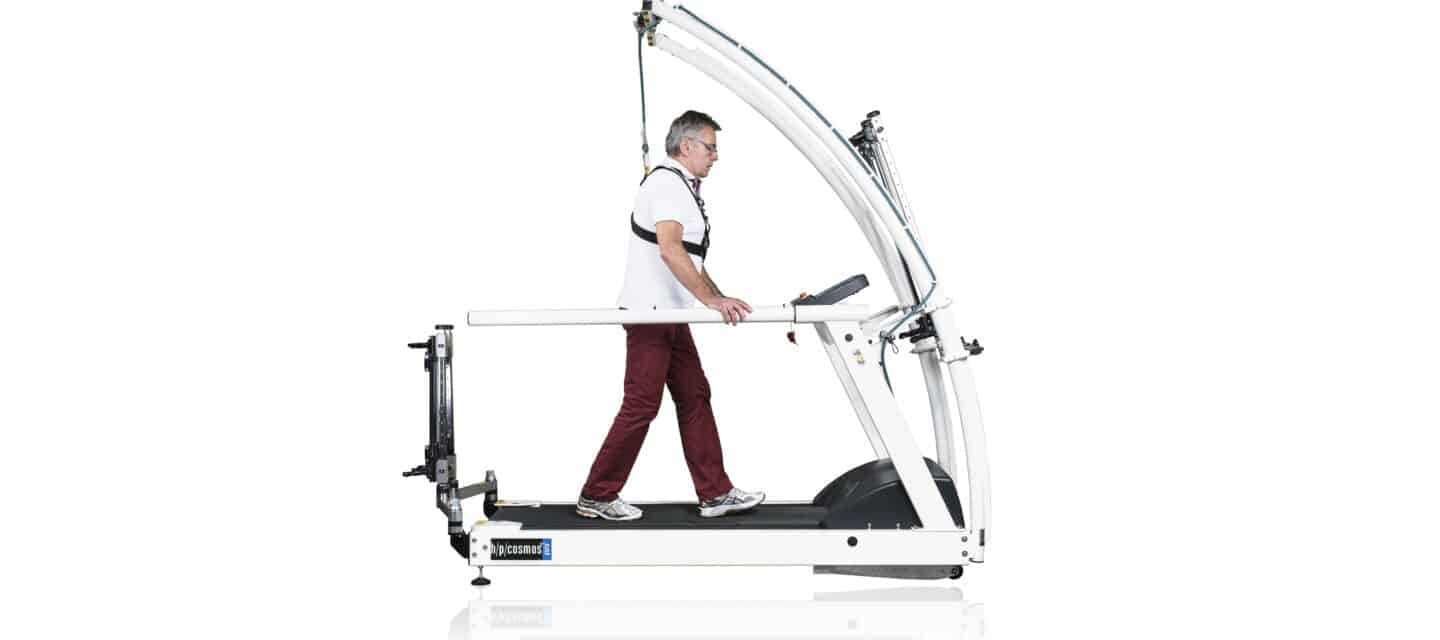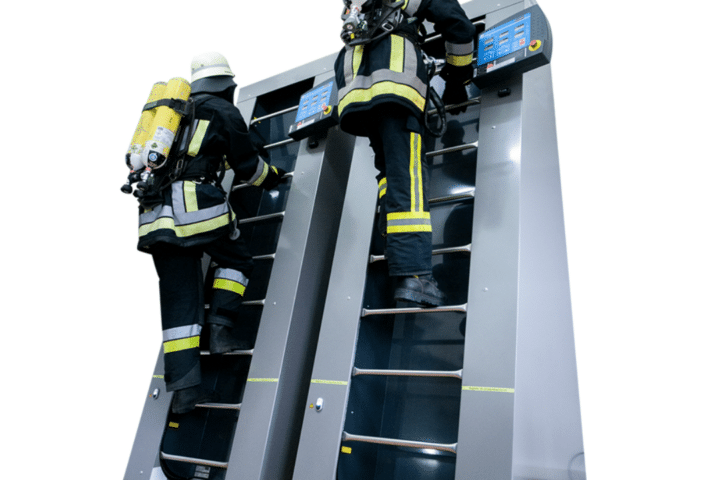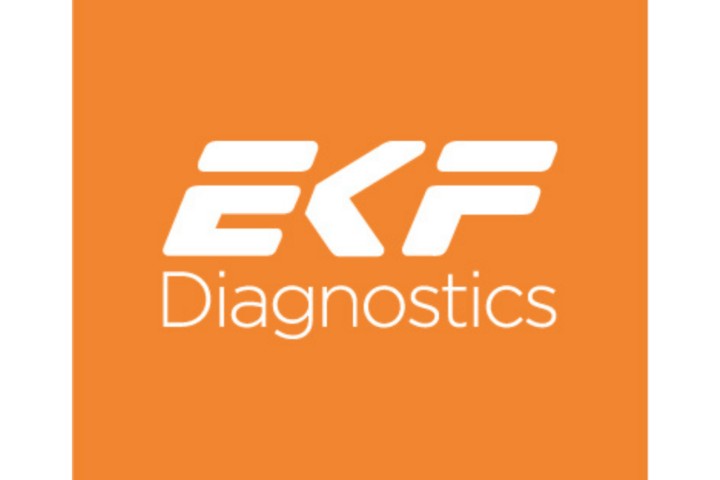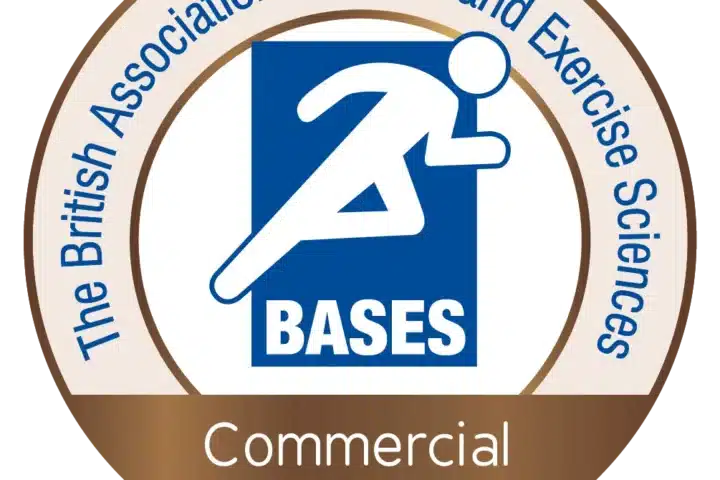Rehabilitation science is advancing rapidly, with innovative techniques offering new ways to enhance recovery and improve patient outcomes. One such method is perturbation training—a technique that challenges balance and stability to improve motor control, strength, and neuromuscular coordination. When combined with the advanced features of h/p/cosmos treadmill ergometers, perturbation training becomes a safe, efficient, and transformative tool in rehabilitation.
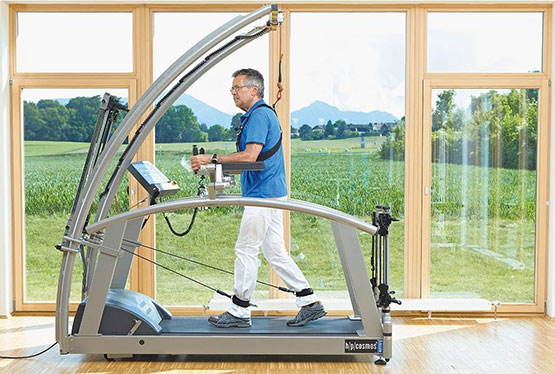
What is Perturbation?
Perturbation refers to deliberate disturbances or forces that disrupt a system’s normal behaviour, challenging its stability. In rehabilitation, perturbation involves applying controlled external forces or movements that create imbalance, requiring patients to adjust their posture or movements to regain stability.
By training the body to respond effectively to such disturbances, perturbation enhances functional movement, reduces the risk of falls, and improves overall coordination.
Why Perturbation Training Matters: Key Benefits
Perturbation training delivers numerous benefits that make it a standout approach in rehabilitation:
- Improved Balance and Stability: Patients learn to recover quickly from sudden disturbances, leading to better mobility and fewer falls in real-world scenarios.
- Enhanced Neuroplasticity: Controlled perturbations stimulate the brain to create and strengthen neural pathways, which is crucial for recovery in neurological conditions.
- Customised Progression: The ability to adjust training intensity and complexity ensures programmes are tailored to individual needs, from early rehabilitation to advanced stages.
- Safe and Controlled Environment: With features like safety arches and harness systems, h/p/cosmos treadmills allow patients to push their limits without fear of injury.
- Dual-Task Training: Combining cognitive tasks with physical challenges enhances multitasking capabilities, replicating everyday scenarios for more effective rehabilitation.
Perturbation training has been widely studied and shown to be an effective intervention for improving balance, reducing fall risk, and enhancing motor control, especially in populations at high risk of falls such as older adults, individuals with neurological conditions, and those recovering from musculoskeletal injuries. Below are some key findings from research studies.
Evidence Supporting Perturbation Training
Improves Reactive Balance Responses
Kurz, I. et al. (2016) found that perturbation-based training significantly improved balance control and voluntary stepping times in older adults. The study demonstrated that unexpected perturbations during walking enhanced participants’ ability to react quickly and maintain stability, highlighting its effectiveness in fall prevention programmes.
Kurz, I., Gimmon, Y., Shapiro, A., Debi, R., Snir, Y. and Melzer, I. (2016). Unexpected perturbations training improves balance control and voluntary stepping times in older adults – a double blind randomized control trial. BMC Geriatrics, 16(1), p.58. Available at: https://pmc.ncbi.nlm.nih.gov/articles/PMC4778347/
Effective for Neurological Rehabilitation
Liu, X., Bhatt, T., and Pai, Y.-C. (2016) studied the effects of treadmill-based slip training in individuals with neurological deficits. The results showed that repeated perturbations improved the participants’ ability to generalise the learned responses, reducing their risk of falls in daily life.
Liu, X., Bhatt, T. and Pai, Y.-C. (2016). Intensity and generalization of treadmill slip training: High or low, progressive increase or decrease? Journal of Biomechanics, 49(2), pp.135–140. Available at: https://pmc.ncbi.nlm.nih.gov/articles/PMC4691437/
Prevention of Falls in Older Adults
McCrum et al. (2017) conducted a systematic review and concluded that perturbation training paradigms effectively improved reactive stepping responses in older adults. The review emphasised the importance of realistic training scenarios to enhance generalisation to real-world fall events.
McCrum, C., Gerards, M.H., Karamanidis, K., Zijlstra, W. and Meijer, K. (2017). A systematic review of gait perturbation paradigms for improving reactive stepping responses and falls risk among healthy older adults. European Review of Aging and Physical Activity, 14(1), p.3. Available at: https://eurapa.biomedcentral.com/articles/10.1186/s11556-017-0173-7
Application in Stroke Rehabilitation
Pigman et al. (2019) explored treadmill-induced perturbation training in individuals with chronic stroke. The study showed that such training improved gait stability and confidence, supporting its use as an intervention for stroke survivors.
Pigman, J., Reisman, D.S., Pohlig, R.T., Wright, T.R. and Crenshaw, J.R. (2019). The development and feasibility of treadmill-induced fall recovery training applied to individuals with chronic stroke. BMC Neurology, 19(1), p.102. Available at: https://bmcneurol.biomedcentral.com/articles/10.1186/s12883-019-1320-8
Improving reactive balance and reducing falls
Pai et al. (2019) investigated the effects of perturbation training using a h/p/cosmos pulsar on neuromuscular responses and motor adaptation. The study found that repeated exposure to perturbations during treadmill walking improved participants’ reactive balance strategies, reducing the likelihood of falls. It highlighted that adaptive neural mechanisms, such as motor learning and improved proprioceptive feedback, played a significant role in enhancing stability.
Additionally, the study emphasised the importance of task-specific training and variability in perturbation scenarios to maximise generalisation to real-world settings. This aligns with findings from previous research, further validating the utility of perturbation-based balance training.
Pai, Y.-C., Bhatt, T., Yang, F. and Wang, E. (2019). Learning from laboratory-induced falling: long-term motor retention among older adults. Journal of Neurophysiology, 122(3), pp.731–740. Available at: https://doi.org/10.1152/jn.00380.2019
Applying Perturbation in Rehabilitation
In practice, perturbation training uses controlled, unpredictable challenges to simulate real-world scenarios like tripping, slipping, or sudden changes in balance. These disturbances can be:
- Physical: Sudden changes in treadmill speed, belt direction, or surface movement.
- Environmental: Adjustments to visual or sensory inputs that challenge balance perception.
This type of training promotes neuro-muscular adaptation, helping patients refine their reflexive and voluntary responses to achieve greater balance, proprioception (the body’s ability to sense movement, action, and location), and coordination.
How h/p/cosmos Treadmills Facilitate Perturbation Training
h/p/cosmos treadmill ergometers are specifically designed to bring the benefits of perturbation training into a controlled, safe, and highly effective environment. Their advanced features include:
- Controlled Speed and Acceleration: Rapid and precise adjustments simulate real-life challenges, enabling patients to practise recovery strategies safely.
- Reversible Belt Movements: Sudden backward movements replicate slipping scenarios, training reaction times and improving gait stability.
- Perturbation Modules: The system includes a ‘random factor’ feature, introducing unpredictability to disturbances for realistic training scenarios.
- Integration with Assistive Devices: Devices like the Airwalk® ap unweighting system provide partial body weight support, enabling early rehabilitation for patients with severe mobility impairments.
- Real-Time Monitoring and Feedback: Therapists can track performance data, assess progress, and adjust training parameters in real time for optimal outcomes.
Improving Gait Stability
One of the most significant applications of perturbation training is improving gait stability. This is particularly important for individuals recovering from neurological or musculoskeletal conditions or those at risk of falls.
Using h/p/cosmos treadmills, therapists can deliver precise, targeted perturbations that help patients practise stabilisation strategies. Features like sudden accelerations or decelerations simulate everyday challenges, training patients to respond reflexively and regain balance. Additionally, dual-task training—combining physical and cognitive challenges—enhances multitasking capabilities, improving both motor and cognitive functions.
Watch the webinar from h/p/cosmos about gait stability training:
Experience Perturbation Training in Action
Perturbation training on h/p/cosmos treadmills is a game-changer in rehabilitation, offering safe, controlled, and customisable programmes to improve patient outcomes. Whether you’re focused on fall prevention, neurological recovery, or advanced sports rehabilitation, h/p/cosmos treadmills provide a versatile platform for cutting-edge therapy.
Configurations for h/p/cosmos Treadmills
h/p/cosmos offers specific configurations to maximise the effectiveness and safety of perturbation training on their treadmills. These setups are tailored for different models, ensuring compatibility with advanced features like the perturbation module and safety equipment.
Some of these configurations include features such as:
- Safety Systems: Both configurations include mandatory fall prevention systems (safety arch and harness) to ensure patient safety during sudden perturbations.
- Perturbation Software: Specialised software provides random and customisable perturbations for slips, trips, and sudden stops, critical for reactive stability training.
- Customisation Options: Sliding bars in the quick generator enable therapists to set parameters for training duration, frequency, and intensity, ensuring individualised sessions.
- Dual-Task Training Integration: Compatible with cognitive testing like Stroop tasks and logic puzzles to add complexity and realism to training.
- These configurations represent a robust and scalable approach to gait rehabilitation and fall prevention, ensuring that clinics and hospitals can deliver cutting-edge care tailored to their patient populations.
We can guide you through the ideal configuration for your practice or clinic. See below for contact details to talk with one of our knowledgeable sales professionals.
Conclusion
Perturbation training is a proven, evidence-based method for improving balance, enhancing gait stability, and reducing fall risks across various patient populations. When combined with the advanced features of h/p/cosmos treadmill ergometers, this innovative approach offers a safe and effective platform for rehabilitation. From neurological recovery to fall prevention and sports rehabilitation, h/p/cosmos treadmills empower therapists to deliver tailored, dynamic, and impactful training programmes.
With robust safety systems, advanced perturbation modules, and seamless integration of cognitive dual-task exercises, these treadmills represent the gold standard in rehabilitation technology. Whether it’s addressing the needs of older adults, stroke survivors, or athletes, h/p/cosmos systems are designed to adapt to and excel in any clinical setting.
Ready to bring the power of perturbation training to your practice?
HaB Direct is the exclusive UK distributor of h/p/cosmos treadmill ergometers, offering the latest models and configurations tailored for your rehabilitation needs.
Contact HaB Direct today to learn more about how h/p/cosmos treadmills can transform your rehabilitation programmes. Fill in the enquiry form below or call us at +44 (0)1926 816 100 to get started. Experience the future of rehabilitation with h/p/cosmos!
General Enquiry
* indicates required fields

